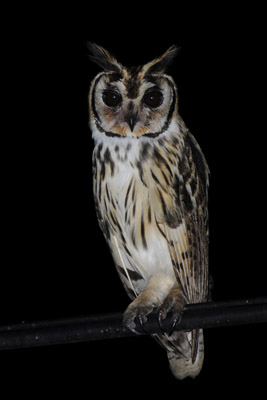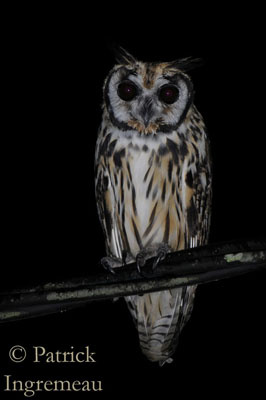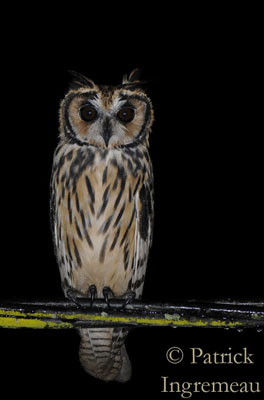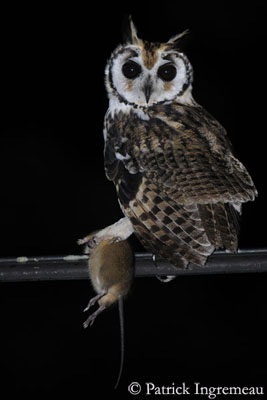
Striped Owl
Asio clamator
Strigiforme Order – Strigidae Family
BIOMETRICS:
Length: 30-38 cm; Wingspan: 76-94 cm; Weight: M: 320-350gr – F: 400-500gr.
DESCRIPTION:
The Striped Owl first description was made by Louis Jean Pierre Vieillot in 1807, thanks to a Cayenne specimen.
The male adult is a medium-sized owl with short wings and long tail.

The upperparts are tawny-buff to cinnamon-buff, with fine vermiculations and heavy blackish streaks. The flight feathers and the tail are barred dark brown.
On the underparts, the throat is white. Breast and belly are buffy-white, with bold blackish stripes. Undertail feathers are whitish, barred with fine blackish bands.
The under wings are pale buff with conspicuous dark carpal patch. Outer primaries shows dark bars at tips.
On the head, crown and nape are dark brown streaked and mottled buff. We can see long, blackish-brown ear-tufts. The facial disk is whitish, with conspicuous black border.
The narrow, hooked bill is dark grey to blackish. The eyes are dark brown. The feathered legs and the feet are dark grey, with black claws.
Both sexes are similar, with female slightly larger than male.
The juvenile resembles adults, but it has cinnamon to buffy-white facial disk. On the body, its plumage is rather buff, with greyish to dark brown streaks.
The Striped Owl has four subspecies:
A.c. forbesi is smaller, and it is found in S. Mexico to Panama.
A.c. clamator lives in Colombia and Venezuela to eastern Peru and Brazil.
A.c. oberi lives in Trinidad and Tobago.
A.c. midas is paler and larger. It is found in Bolivia and Brazil, to northern Argentina and Uruguay.
VOICE: SOUNDS BY XENO-CANTO
The Striped Owl utters a loud, long “wheeyoo”. The male usually gives series of hoots “hooOOOoh”. The female utters higher-pitched song. Both also give series of barks “hu-how-how-how”.
Juvenile and immature give high-pitched whistled screams.
HABITAT:
The Striped Owl lives in varied habitats, such as tropical forest and edges, savannahs, marshes, open and semi-open grasslands, woodland patches, cultivated areas and suburban zones.
It may be seen from sea-level up to 1400 metres of elevation.
RANGE:
The Striped Owl is found from southern Mexico to Panama, and in northern South America, in Uruguay and north Argentina. It avoids the Amazon Basin.
BEHAVIOUR:
The Striped Owl is sedentary within its range. It may be seen alone, in pairs or in small groups.
This species may be gregarious, and the birds gather at roost in flocks of about 10 to 12 owls.

The Striped Owl feeds primarily on rodents and other small mammals, some birds such as doves, and large insects. This owl hunts mainly at dusk and by night. It performs a low flight over the open country, and makes abrupt dives after the prey. It may also hunt from a perch, watching for preys, and dropping down when detected.
During the day, the Striped Owl rests, hidden into the dense foliage of trees and shrubs. It may be found on the ground, concealed under the cover of vegetation. Outside the breeding season, they roost in small flocks by day time. Their cryptic plumage allows these birds to be almost invisible.
At the beginning of the breeding season, the male vocalizes. It may perform some wing-clapping displays while flying. Some displays may occur at the nest-site, such as ritualized scraping. The male performs courtship feeding, bringing preys to the female.
FLIGHT:
The Striped owl flies with rapid, shallow wing beats over open lands.
REPRODUCTION:
Breeding season may vary, but it occurs mainly from August to March, according to the location.
The Striped Owl nests on the flat ground, hidden into long grassy clumps or thick bush. Some nests can be found in trees.

The female lays 2 to 4 eggs. Incubation lasts about one month to 33 days, by female alone. Usually, only one or two chick fledges.
The male provides food for female and young. The female takes the prey from the male, and she tears it into small pieces for the chicks. Later, the male drops the prey at nest when the young are able to feed themselves.
The young remain with parents during several weeks after fledging.
Fr: Hibou strié
All: Schreieule
Esp: Búho Gritón
Ital: Gufo striato
Nd: Gestreepte Ransuil
Russe: Полосатая Сова
Photographs by Patrick Ingremeau
His website: TAMANDUA
Texte de Nicole Bouglouan
Sources:
A GUIDE TO THE BIRDS OF MEXICO AND NORTHERN CENTRAL AMERICA by Steve N. G. Howell, Sophie Webb - Oxford University Press - ISBN: 0198540124
HANDBOOK OF THE BIRDS OF THE WORLD Vol. 2 by Josep del Hoyo-Andrew Elliot--Jordi Sargatal - Lynx Edicions - ISBN: 8487334156
A GUIDE TO THE BIRDS OF COLOMBIA by Steven L. Hilty and William L. Brown
Princeton University Press – ISBN 069108372X

DIET:
The Striped Owl feeds mainly on small mammals, medium-sized birds, large insects such as grasshoppers and some reptiles. It regularly rejects pellets including the indigested parts of its preys.
PROTECTION / MENACES / STATUS:
The Striped Owl is killed by vehicles and shooting. But it has natural predators such as birds of prey and larger owls.
This species is widespread but, according to the range, it may be local or uncommon.
However, this species is not threatened at this moment.